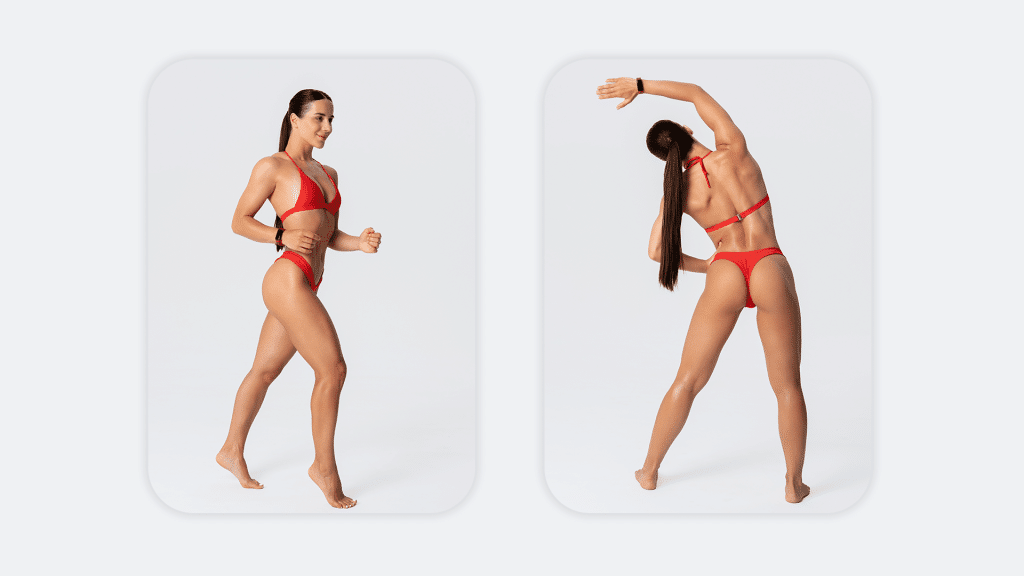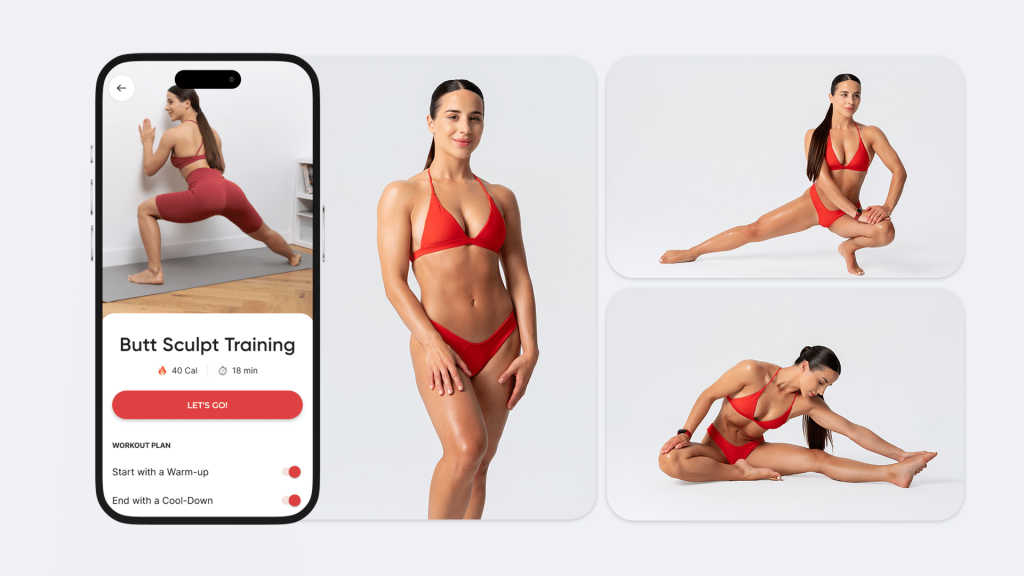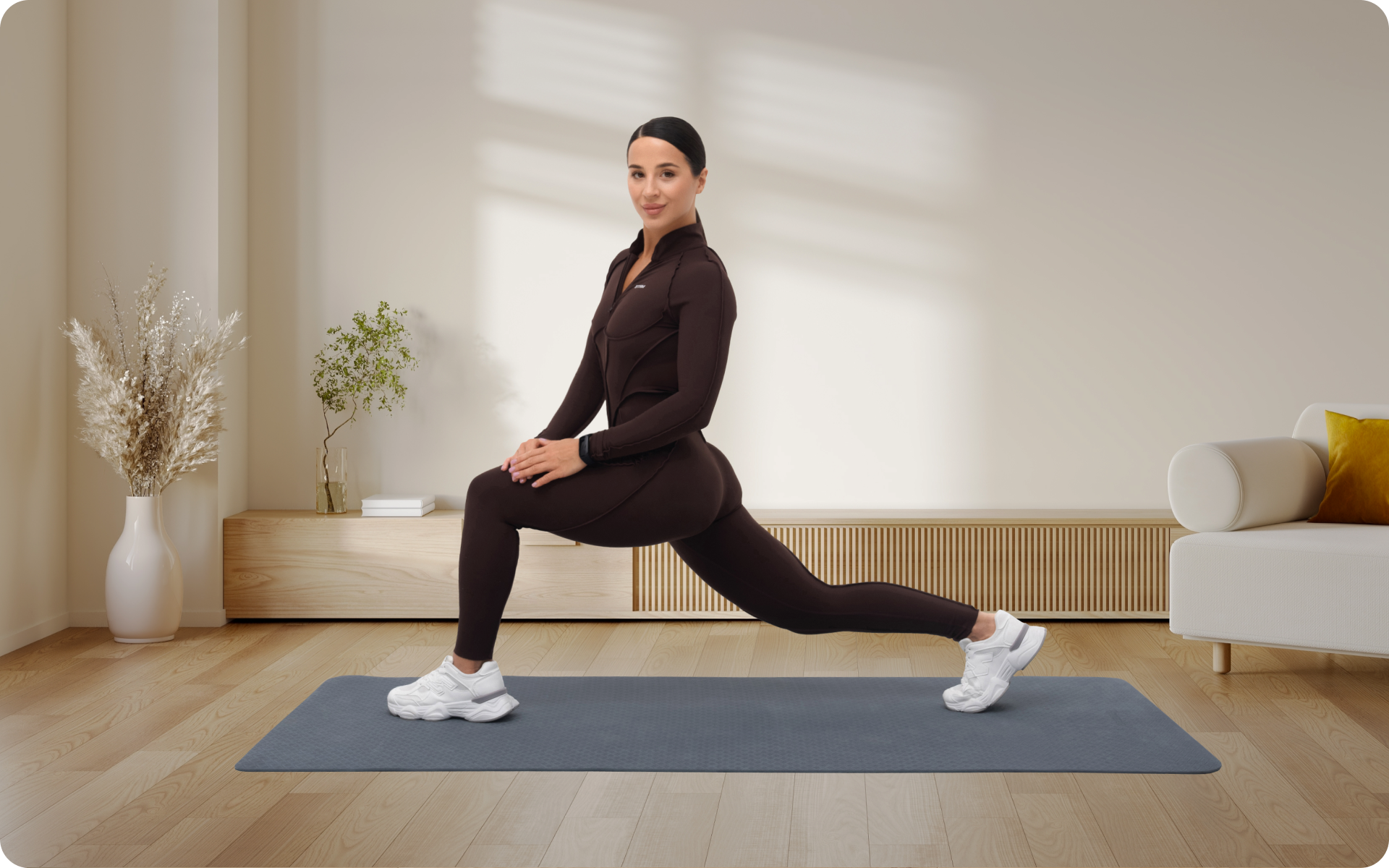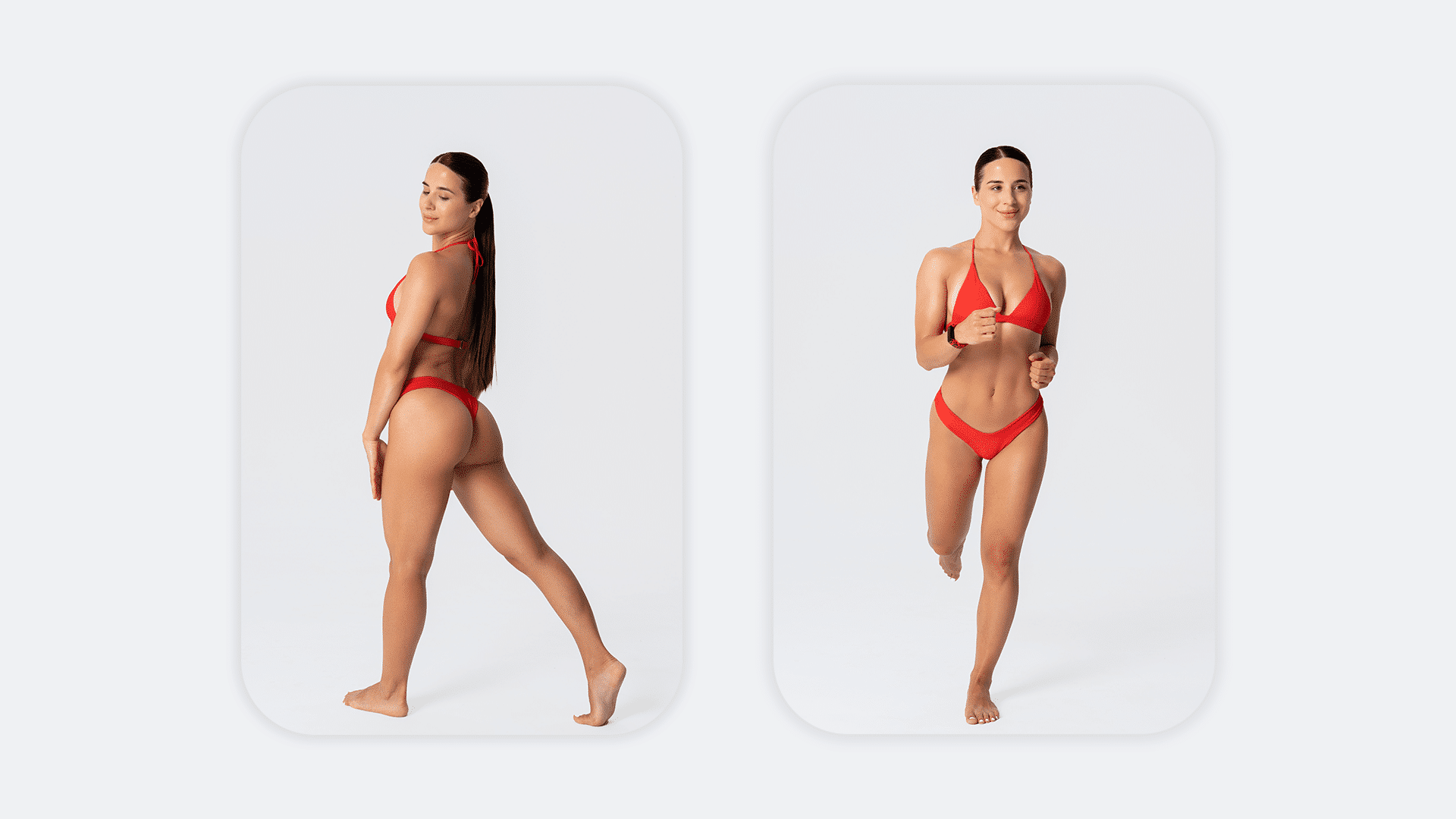The benefits of High-Intensity Interval Training (HIIT) workouts are well-documented. According to the American College of Sports Medicine, these short, intense bursts of exercise can improve cardiovascular fitness, lower body fat, and support muscle mass (3). As summer approaches and the beach beckons and many of us look for ways to get in shape while enjoying the great outdoors, why not make HIIT a part of your beach workouts? We’ve put together an effective, enjoyable, and challenging workout that harnesses the natural resistance of sand and the refreshing sea breeze to supercharge your fitness this season. Whether you’re a seasoned fitness enthusiast or just starting out on your journey, this could be the perfect way to make the most of your summer. Let’s dive right in!
What Is HIIT Beach Workout?
A High-Intensity Interval Training (HIIT) beach workout is a type of exercise regimen that combines the principles of HIIT with the natural environment of a beach.
HIIT involves alternating between short, intense bursts of exercise and less intense recovery periods. This kind of training is known to effectively boost cardiovascular fitness, lower body fat, and support muscle mass and increase calories burned.
When you take this concept to the beach, you’re adding a new layer of challenge and benefit.
The sand provides a unique resistance compared to solid ground, which can intensify the workout and engage different muscle groups.
The beach setting also allows for exercises such as sprints, lunges, or jumps that use the whole body and are more challenging on an unstable surface like sand.
In addition, the beach environment can make the workout more enjoyable. The beautiful scenery, the sound of the waves, and the fresh sea breeze can be motivating and stress-relieving. What’s more, after your workout you can cool down with a refreshing swim.
A HIIT beach workout is essentially a high-intensity interval training session that leverages the natural elements of a beach to provide a full-body, efficient, and enjoyable workout.
HIIT Beach Workout Routine – Full Body
This full-body HIIT workout takes advantage of the sand for added resistance and challenge. It’s designed to be performed three times a week with at least one day of rest in between each session. No equipment is needed.
Warm-Up
Start with a 5-10 minute jog along the shoreline to get your muscles warm and ready.
The Workout
Beach Sprints
Find a stretch of sand and sprint as fast as you can for 30 seconds. The sand will add extra resistance compared to running on solid ground.
Rest
Walk back to your starting point, this should take about 60 seconds and allow you to recover.
Sand Push-Ups
Perform push-ups for 30 seconds.
- Plant your hands in the sand wider than shoulder width, keep your body straight and lower until your chest nearly touches the sand, then push back up.
- Beginners can do this on their knees.
Rest: 60 seconds
Read More: 6 Beach Workout Ideas To Try This Summer
Surf Squats
- Stand with your feet wider than hip-width apart, toes pointed slightly outwards.
- Lower into a squat (like you’re sitting on a surfboard), then explode up, jumping vertically and landing softly back into the squat.
- Repeat for 30 seconds.
Rest: 60 seconds
Beach Burpees
- From a standing position, squat down, place your hands in the sand, and jump your feet back into a plank.
- Do a push-up, then jump your feet back to your hands, stand up, and perform a vertical jump.
- Repeat for 30 seconds.
Rest: 60 seconds
Crab Walks
- Sit on the sand with your feet hip-width apart in front of you, palms planted behind you.
- Lift your hips off the sand and walk forward on your hands and feet like a crab for 30 seconds.
This completes one round. Rest for 2 minutes, then repeat the entire sequence two more times for a total of three rounds.
Cool-Down
After your workout, cool down with 5-10 minutes of stretching.
HIIT Beach Workout Routine – Upper Body
This routine will target your arms, shoulders, chest, and back. It’s designed to be performed three times a week with at least one day of rest in between each session. No equipment is needed.
Warm-Up
Start with a 5-10 minute jog along the shoreline to get your muscles warm and ready.
The Workout
Push-Ups
- Plant your hands in the sand wider than shoulder width, keep your body straight and lower until your chest nearly touches the sand, then push back up.
- Do this for 30 seconds. Beginners can do this on their knees.
Rest: 60 seconds
Dips
- Find a stable surface like a low wall or step.
- Sit on the edge, place your hands next to your hips, walk your feet out in front of you, then lower your body by bending your elbows.
- Push back up to the starting position. Do this for 30 seconds.
Rest: 60 seconds
BetterMe app will kick you out of the mental funk, shake off your extra weight, rid you off your energy-zapping habits, and help you sculpt the body of your dreams. Intrigued? Hurry up and change your life for the better!
Plank To Dolphin
- Start in a forearm plank position.
- Push your hips back and up towards the sky (like a downward dog pose but on your forearms), then return to the plank position.
- Repeat for 30 seconds.
Rest: 60 seconds
Sand Burpees
- From a standing position, squat down, place your hands in the sand, and jump your feet back into a plank.
- Do a push-up, then jump your feet back to your hands, stand up, and perform a small jump.
- Repeat for 30 seconds.
Rest: 60 seconds
Crab Walks
- Sit on the sand with your feet hip-width apart in front of you, palms planted behind you.
- Lift your hips off the sand and walk forward on your hands and feet like a crab for 30 seconds.
This completes one round. Rest for 2 minutes, then repeat the entire sequence two more times for a total of three rounds.
Cool-Down
After your workout, cool down with 5-10 minutes of stretching.
HIIT Beach Workout Routine – Lower Body
This routine will target your glutes, quads, hamstrings, and calves. It’s designed to be performed three times a week with at least one day of rest in between each session. No equipment is needed.
Warm-Up
Start with a 5-10 minute jog along the shoreline to get your muscles warm and ready.
The Workout
Beach Sprints
- Find a stretch of sand and sprint as fast as you can for 30 seconds. The sand will add extra resistance compared to running on solid ground.
Rest
Walk back to your starting point, this should take about 60 seconds and allow you to recover.
Lunges
- Stand tall and step forward with one foot until your leg reaches a 90-degree angle.
- Your rear knee should remain parallel to the ground, or if your mobility allows, you can lightly tap the ground with that knee
- Alternate legs for 30 seconds.
Rest: 60 seconds
Squat Jumps
- Lower into a squat and then explode up into a jump, landing softly back into the squat position.
- Repeat for 30 seconds.
Rest: 60 seconds
Side Shuffles
- Start in a half-squat position, shuffle to your right for 10 steps (or however many steps the space allows), then shuffle to your left for the same number of steps.
- Stay in the half-squat position the whole time.
- Repeat for 30 seconds.
Rest: 60 seconds
Read More: 8 Beach Exercises To Do For A Full Body Workout
Single-Leg Glute Bridge
- Lie on your back with your knees bent and your feet flat on the sand.
- Extend one leg straight out.
- Push through your planted heel and lift your hips off the ground.
- Lower back down and repeat for 15 seconds, then switch legs.
This completes one round. Rest for 2 minutes, then repeat the entire sequence two more times for a total of three rounds.
Cool-Down
After your workout, cool down with 5-10 minutes of stretching.
HIIT Beach Workout Routine – Core
This routine targets your abs, obliques, and lower back muscles. It’s designed to be performed three times a week with at least one day of rest in between each session. No equipment is needed.
Warm-Up
Start with a 5-10 minute jog along the shoreline to get your muscles warm and ready.
The Workout
Plank
- Get into a push-up position but rest on your forearms instead of your hands. Keep your body in a straight line from your shoulders to your ankles.
- Hold this position for 30 seconds.
Rest: 60 seconds
Mountain Climbers
- Start in a high plank position.
- Bring one knee toward your chest, then switch and bring the other knee forward, like you’re running in place.
- Do this for 30 seconds.
Rest: 60 seconds
Russian Twists
- Sit on the sand and lean back slightly while keeping your back straight.
- Lift your feet off the ground and twist your torso from side to side, touching the sand next to your hip with both hands each time you twist.
- Do this for 30 seconds.
Rest: 60 seconds
Superman Pulls
- Lie face down on the sand with your arms stretched out in front of you.
- Lift your arms, chest, and legs off the sand, then pull your elbows back towards your hips, squeezing your shoulder blades together.
- Extend your arms back out and repeat for 30 seconds.
Rest: 60 seconds
Lean and toned up body isn’t just a far-fetched fantasy. Check out the BetterMe app and watch it propel your weight loss journey into high gear!
V-Ups
- Lie on your back on the sand, extend your arms behind your head and keep your feet together.
- Lift your hands and feet at the same time, reaching for your toes, then lower back down.
- Repeat for 30 seconds.
This completes one round. Rest for 2 minutes, then repeat the entire sequence two more times for a total of three rounds.
Cool-Down
After your workout, cool down with 5-10 minutes of stretching.
Can You Burn 500 Calories With HIIT At The Beach?
Yes, it’s possible to burn around 500 calories with a HIIT workout at the beach, but the exact number will depend on several factors such as your weight, fitness level, the intensity and duration of the workout.
According to a study published in the Journal of Obesity, HIIT workouts can effectively burn calories and reduce body fat (2). The American Council on Exercise (ACE) also notes that HIIT workouts are highly efficient for calorie burning (4).
When you perform a HIIT workout on the beach, the uneven and shifting surface of the sand adds an extra element of resistance, making your muscles work harder and potentially increasing the calorie burn.
A study in the Journal of Science and Medicine in Sport found that running on sand requires 1.6 times more energy expenditure than running on a hard surface (9). However, remember that these figures are estimates and individual results can vary.
How Many HIIT Workouts Per Day On The Beach?
One HIIT workout per day is typically enough to see results.
Most experts recommend performing no more than three HIIT workouts per week. This is because HIIT is an intense form of exercise that can put significant stress on the body and can lead to overtraining if done too frequently.
We acknowledge the importance of getting sufficient rest, as it’s essential for muscle recovery and growth. That’s why we recommend spacing out your HIIT workouts at least one day apart.
When performing HIIT at the beach, you should also factor in other variables such as the temperature, sun exposure, and sand conditions to ensure that you’re doing the workout safely.
All said and done—Choosing the right workout frequency for optimal results depends on several factors, including your fitness goals, current fitness level, the type of workouts you’re doing, and how much time you have to devote to exercise. Here are some general guidelines to consider:
Aim For Consistency
The American Heart Association recommends at least 150 minutes of moderate-intensity aerobic activity or 75 minutes of vigorous aerobic activity per week, or a combination of both, preferably spread throughout the week (1).
Consider Your Fitness Goals
If you’re aiming for weight loss or improved cardiovascular health, you might need to do more aerobic exercise.
For muscle gain, strength training is crucial. The American College of Sports Medicine recommends two to three days per week of strength training for each major muscle group (7).
Don’t Forget Recovery Time
Rest is essential for muscle recovery and growth. Avoid working out with the same muscle group on consecutive days.
Listen To Your Body
It’s important to pay attention to how your body feels. If you’re feeling tired, sore, or notice a decrease in performance, you may need more recovery time between workouts.
Is 20 Minutes Of HIIT Per Day Enough?
Yes, 20 minutes of HIIT per day can be enough to see results, depending on the intensity of the exercise and your current fitness level.
The effectiveness of 20 minutes of High-Intensity Interval Training (HIIT) per day is supported by scientific research. Studies have shown that even short bouts of HIIT can lead to significant improvements in cardiovascular fitness, metabolic function, and body composition.
A study published in PLOS One found that a 10-week program of 4-minute HIIT sessions done 3 times per week improved VO2max (a measure of cardiovascular fitness) and metabolic health markers in sedentary adults (5).
Another study published in the Journal of Physiology showed that short HIIT workouts (about 20 minutes, three times per week) led to similar improvements in muscle oxidative capacity, glucose tolerance, and insulin sensitivity as traditional endurance training, despite a five-fold lower exercise volume and time commitment (6).
However, while these studies suggest that 20-minute HIIT workouts can be beneficial, the exact amount of time you need to spend exercising depends on your fitness goals and current level of fitness.
For instance, if your goal is to lose weight, you may need to increase the time spent exercising as well as focus on other key components such as diet and sleep.
The American College of Sports Medicine recommends that people who are trying to lose weight should aim for 150–250 minutes of moderate-intensity exercise, or 75–150 minutes of vigorous-intensity exercise, per week (7).
Assuming that HIIT workouts are done 3 times per week, this would mean that each session should last 30–50 minutes.
The Bottom Line
This comprehensive HIIT beach workout plan is designed to target your full body, upper body, lower body, and core in different sessions.
It’s a perfect blend of cardio and strength training that you can do without any equipment, right on the beach. Whether you’re a beginner or a seasoned fitness enthusiast, this routine offers modifications to suit all fitness levels.
DISCLAIMER:
This article is intended for general informational purposes only and does not serve to address individual circumstances. It is not a substitute for professional advice or help and should not be relied on for making any kind of decision-making. Any action taken as a direct or indirect result of the information in this article is entirely at your own risk and is your sole responsibility.
BetterMe, its content staff, and its medical advisors accept no responsibility for inaccuracies, errors, misstatements, inconsistencies, or omissions and specifically disclaim any liability, loss or risk, personal, professional or otherwise, which may be incurred as a consequence, directly or indirectly, of the use and/or application of any content.
You should always seek the advice of your physician or other qualified health provider with any questions you may have regarding a medical condition or your specific situation. Never disregard professional medical advice or delay seeking it because of BetterMe content. If you suspect or think you may have a medical emergency, call your doctor.
SOURCES:
- American Heart Association Recommendations for Physical Activity in Adults and Kids (2018, heart.org)
- High-Intensity Intermittent Exercise and Fat Loss (2011, nih.gov)
- High-Intensity Interval Training (n.d., acms.org)
- High-intensity Interval Training: Why it Works (2017, acefitness.org)
- Low-Volume High-Intensity Interval Training in a Gym Setting Improves Cardio-Metabolic and Psychological Health (2015, plos.org)
- Low-volume high-intensity interval training reduces hyperglycemia and increases muscle mitochondrial capacity in patients with type 2 diabetes (2011, physiology.org)
- Physical Activity Guidelines (n.d., acms.org)
- The Effect of Resistance Training in Healthy Adults on Body Fat Percentage, Fat Mass and Visceral Fat: A Systematic Review and Meta-Analysis (2021, pubmed.gov)
- The energy cost of running on grass compared to soft dry beach sand (2001, sciencedirect.com)



















